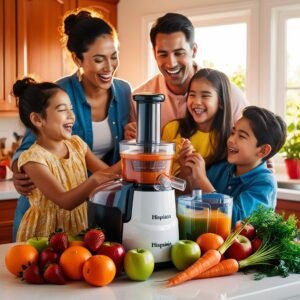What comes to mind when you think about juicing? Is it the fresh, vibrant flavors of fruits and vegetables just waiting to burst in your mouth, or is it the health benefits that come with that glass of juice you’re dreaming of? Whatever your motivation, choosing the right juicer can play a crucial role in how enjoyable and beneficial your juicing experience will be.
Understanding Different Types of Juicers
When you’re on the hunt for the best juicer, the first thing you need to understand is that there are several types available, each with its own set of features and benefits.
Centrifugal Juicers
Centrifugal juicers are some of the most common options available on the market. They work by rapidly spinning fruits and vegetables against a mesh filter, separating the juice from the pulp through centrifugal force.
- Speed: These juicers are known for their speed, allowing you to whip up a glass of juice in just a minute or two.
- Convenience: They often come with large feed chutes, which means less chopping and prep time. You can toss whole apples or large chunks of carrots right in.
- Juice Quality: However, it’s worth noting that the heat generated by the spinning process can lead to oxidation, potentially affecting the taste and nutritional value of your juice.

Masticating Juicers
Masticating juicers, also known as slow juicers or cold press juicers, utilize a different mechanism. Instead of spinning, they crush and grind the produce to extract juice, which can result in a higher-quality beverage.
- Juice Quality: Because they operate at a slower speed, masticating juicers produce less heat and oxidation. This means that your juice will retain more nutrients and flavor.
- Versatility: These juicers can often handle leafy greens, nuts, and even make nut butters, giving you more options in your kitchen.
- Preparation Time: They may require more prep time, as you’ll be cutting ingredients into smaller pieces and they typically have smaller feed chutes.

Triturating Juicers
If you’re looking for efficiency and the highest juice yield, you might want to consider triturating juicers, also known as twin gear juicers. These juicers crush and grind fruits and vegetables using two gears.

- Juice Quality: They excel in juice extraction, especially from leafy greens and fibrous vegetables, resulting in a drier pulp and more nutrient-rich juice.
- Durability: Generally, triturating juicers are built to last and can easily handle heavy-duty juicing sessions.
- Price Point: On the downside, they tend to be among the more expensive options out there and can require more time to clean.
Choosing the Right Type for You
As you consider which type of juicer aligns best with your needs, reflect on your juicing habits and lifestyle. Are you looking for speed and convenience, or do you prioritize juice quality above all else? Each type has its advantages, so assess what matters most to you.
Key Features to Consider
After determining the type of juicer that suits your needs, it’s time to look at specific features. These elements can greatly improve your juicing experience.
Juice Yield
One of the most significant factors is how much juice the machine extracts from its ingredients. Higher juice yield means less waste and, often, more nutrients preserved. Look for juicers that have high juice extraction rates, especially if you plan to juice regularly.

Ease of Cleaning
Juicing can bring joy and health to your life, but cleaning can sometimes feel like a chore. Different juicers have different levels of cleanup required. Centrifugal juicers typically have more parts to disassemble for cleaning, while masticating juicers may have easier-to-clean components. Look for models with dishwasher-safe parts to simplify post-juicing clean-up.
Noise Level
Let’s face it: some juicers can be loud! If you live in an apartment or have young kids, consider how much noise you’re willing to tolerate. Centrifugal juicers, especially, can create quite a racket, while masticating juicers tend to operate much quieter.
Durability and Build Quality
You want your juicer to last, right? Consider the material and build quality. Stainless steel components are generally more durable than plastic, although they may come at a higher price point. Check reviews and warranties for an idea of longevity and durability.
Size and Footprint
Where will you be storing your juicer? If counter space is at a premium in your kitchen, size matters. Centrifugal juicers are usually compact, while some masticating and triturating juicers can take up more room. Be sure to factor in the dimensions before making a purchase.
Budget
Juicers are available at a wide range of price points, so it’s crucial to set a budget that feels right for you. Keep in mind that while the cheapest option may save you money upfront, investing in a higher-quality juicer can offer better yield and durability in the long run.

Evaluating Your Juicing Needs
Now that you know what to look for, let’s take a moment to think about your personal juicing needs. Different lifestyles, diets, and preferences will guide you in making the best decision.
Determine Your Goals
What do you want to achieve with juicing? Are you aiming for weight loss, increased energy, or incorporating more vitamins into your diet? Pinpointing your primary goal can help in choosing a juicer that’s versatile enough to cater to various ingredients.
Frequency of Use
How often do you envision yourself juicing? If you’re planning to juice daily, you might prefer a machine that offers efficiency and ease of cleaning. For occasional use, a budget-friendly centrifugal juicer could suffice.
Types of Ingredients
Think about the kinds of fruits and vegetables you intend to juice. If you’re planning to juice leafy greens or wheatgrass, a masticating or triturating juicer would be a better choice than a centrifugal juicer. Knowing what you want to juice will guide you toward the right machine.
Juicing Techniques and Tips
Once you’ve chosen your juicer, there are some techniques that can enhance your juicing experience. These tips can help you get the most out of your juicing sessions.
Prepare Your Ingredients
Before you turn on your juicer, take a moment to prepare your ingredients. Wash your fruits and vegetables thoroughly to remove any dirt or pesticides. If you’re using roots or hard vegetables, consider peeling them to improve taste and make juicing easier.
Cut Produce to Fit
If you’re using a masticating or triturating juicer, you may need to cut your fruits and vegetables into smaller pieces. This ensures a smooth juicing experience and helps avoid any jams or clogs.
Experiment with Combinations
Don’t hesitate to experiment with different flavor combinations! Mixing fruits and vegetables can create delicious new blends. For instance, try blending carrots with ginger and oranges for a refreshing and invigorating juice.
Use Fresh Ingredients
Freshness is key when it comes to juice quality. Whenever possible, use seasonal produce from your local farmers’ market or grocery store. Fresh ingredients tend to pack more flavor and nutrients, giving you greater benefits from your juice.
Store Juice Wisely
If you want to save some juice for later, store it in airtight glass containers and refrigerate it. However, for the best taste and nutrient retention, it’s advisable to consume the juice shortly after making it.

Troubleshooting Common Issues
Even with the best juicer, you may encounter issues from time to time. Here’s how to troubleshoot common problems you could face while juicing.
Juice Separation
If you notice your juice separating into layers, it’s not a cause for concern. Simply give it a gentle shake before drinking. To minimize separation, store your juice in airtight containers and use it within a few days.
Clogging
If your juicer is clogging, it may be that you are using too many fibrous ingredients without enough moisture. Try alternating between hard and softer ingredients while juicing to improve flow and prevent clogs.
Foaming
Foaming can be a common issue, especially with centrifugal juicers. If you’re looking to reduce foam, you can strain your juice through a fine mesh sieve or cheesecloth before serving.
Pulp Being Ejected Wet
If you notice that your pulp is still quite wet after juicing, this can indicate that your juicer isn’t extracting juice effectively. You might want to check whether you’re using the appropriate settings for the type of produce or consider if the juicer itself may not be working at its full capacity.
Maintaining Your Juicer
Proper maintenance goes a long way toward extending the life of your juicer. Here’s how to keep it in great shape.
Cleaning After Each Use
Make a habit of thoroughly cleaning your juicer immediately after use. Leftover pulp and residue can become stuck and lead to clogs. Most juicers can be disassembled easily for quick cleaning.
Deep Cleaning
Once a month, consider doing a deep cleaning of your juicer. This may involve soaking parts in warm, soapy water or utilizing a vinegar solution to remove any lingering odors or stains.
Regular Inspections
Periodically check for any wear and tear on the juicer’s components. Look for signs of damage or breakage and replace parts as needed to ensure the best performance.

Final Thoughts
Choosing the right juicer can unlock a world of delicious juices packed with nutrients and flavor. Understanding the different types, features, and your own specific needs will make the process much easier. Whether you go for the speed of a centrifugal juicer or the quality of a masticating model, your ideal juicer is out there waiting for you.
Embracing the art of juicing can lead to fresh, vibrant energy and health benefits in your life. So go ahead, take the plunge, and enjoy the journey into the wonderful world of juicing!


